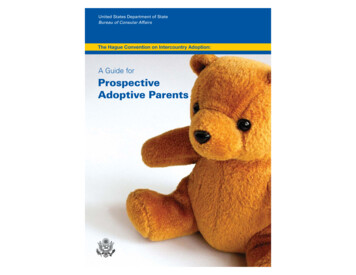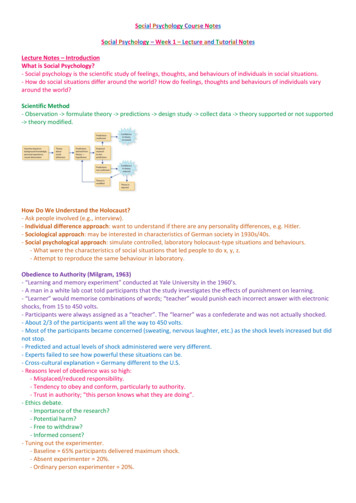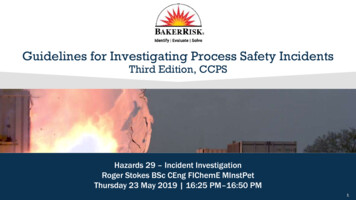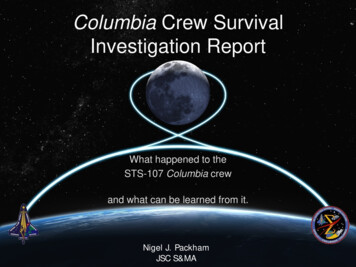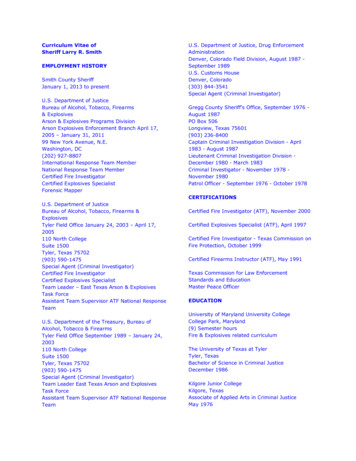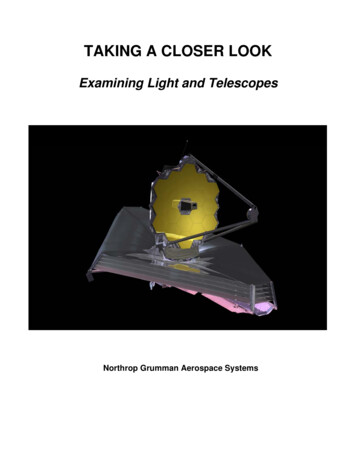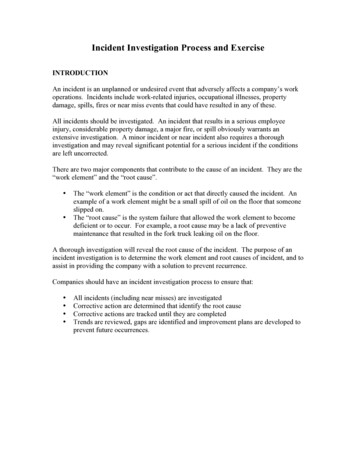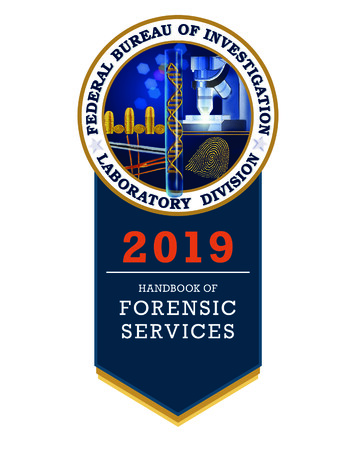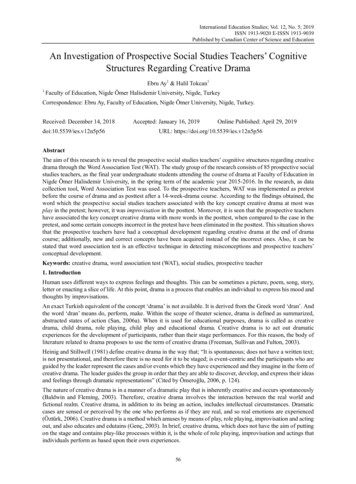
Transcription
International Education Studies; Vol. 12, No. 5; 2019ISSN 1913-9020 E-ISSN 1913-9039Published by Canadian Center of Science and EducationAn Investigation of Prospective Social Studies Teachers’ CognitiveStructures Regarding Creative DramaEbru Ay1 & Halil Tokcan11Faculty of Education, Nigde Ömer Halisdemir University, Nigde, TurkeyCorrespondence: Ebru Ay, Faculty of Education, Nigde Ömer University, Nigde, Turkey.Received: December 14, 2018doi:10.5539/ies.v12n5p56Accepted: January 16, 2019Online Published: April 29, 2019URL: https://doi.org/10.5539/ies.v12n5p56AbstractThe aim of this research is to reveal the prospective social studies teachers’ cognitive structures regarding creativedrama through the Word Association Test (WAT). The study group of the research consists of 85 prospective socialstudies teachers, as the final year undergraduate students attending the course of drama at Faculty of Education inNigde Ömer Halisdemir University, in the spring term of the academic year 2015-2016. In the research, as datacollection tool, Word Association Test was used. To the prospective teachers, WAT was implemented as pretestbefore the course of drama and as posttest after a 14-week-drama course. According to the findings obtained, theword which the prospective social studies teachers associated with the key concept creative drama at most wasplay in the pretest; however, it was improvisation in the posttest. Moreover, it is seen that the prospective teachershave associated the key concept creative drama with more words in the posttest, when compared to the case in thepretest, and some certain concepts incorrect in the pretest have been eliminated in the posttest. This situation showsthat the prospective teachers have had a conceptual development regarding creative drama at the end of dramacourse; additionally, new and correct concepts have been acquired instead of the incorrect ones. Also, it can bestated that word association test is an effective technique in detecting misconceptions and prospective teachers’conceptual development.Keywords: creative drama, word association test (WAT), social studies, prospective teacher1. IntroductionHuman uses different ways to express feelings and thoughts. This can be sometimes a picture, poem, song, story,letter or enacting a slice of life. At this point, drama is a process that enables an individual to express his mood andthoughts by improvisations.An exact Turkish equivalent of the concept ‘drama’ is not available. It is derived from the Greek word ‘dran’. Andthe word ‘dran’ means do, perform, make. Within the scope of theater science, drama is defined as summarized,abstracted states of action (San, 2006a). When it is used for educational purposes, drama is called as creativedrama, child drama, role playing, child play and educational drama. Creative drama is to act out dramaticexperiences for the development of participants, rather than their stage performances. For this reason, the body ofliterature related to drama proposes to use the term of creative drama (Freeman, Sullivan and Fulton, 2003).Heinig and Stillwell (1981) define creative drama in the way that; “It is spontaneous; does not have a written text;is not presentational, and therefore there is no need for it to be staged; is event-centric and the participants who areguided by the leader represent the cases and/or events which they have experienced and they imagine in the form ofcreative drama. The leader guides the group in order that they are able to discover, develop, and express their ideasand feelings through dramatic representations” (Cited by Ömeroğlu, 2006, p. 124).The nature of creative drama is in a manner of a dramatic play that is inherently creative and occurs spontaneously(Baldwin and Fleming, 2003). Therefore, creative drama involves the interaction between the real world andfictional realm. Creative drama, in addition to its being an action, includes intellectual circumstances. Dramaticcases are sensed or perceived by the one who performs as if they are real, and so real emotions are experienced(Öztürk, 2006). Creative drama is a method which amuses by means of play, role playing, improvisation and actingout, and also educates and edutains (Genç, 2003). In brief, creative drama, which does not have the aim of puttingon the stage and contains play-like processes within it, is the whole of role playing, improvisation and actings thatindividuals perform as based upon their own experiences.56
ies.ccsenet.orgInternational Education StudiesVol. 12, No. 5; 2019Creative drama comprises three interrelated stages. These stages are in the following (Adıgüzel, 2006, 2013):1)Warm-up – Preparation: This stage is the preparation for the process, for the participant who has just beguncreative drama studies. Children’s plays and also derived plays can be used. This is the stage at whichactivities are conducted by forming a group and through play-like techniques, and creative drama theme isdetermined.2)Animation – This stage includes the process within which a theme shapes and develops in the course of time,is determined, shaped and all the works of formation are carried out. Creative drama techniques are used inthe animation stage.3)Evaluation – Discussion: The results attained by creative drama studies are evaluated at this stage. Sharing offeelings and thoughts is realized by emphasizing the essence, significance and quality of creative dramaprocess.In creative drama including all these stages mentioned, improvisation and role playing are used as majortechniques. “Improvisation is the creation of a situation in which characters speak spontaneously” (McCaslin,2014, p. 107). As for role playing, it is to act out the personality traits and feelings of the characters in the play(Ömeroğlu, 2006). In addition to these techniques, in creative drama, some certain methods and/or techniques suchas “role reversal, simultaneous improvisation, teacher in role, dramatization, ging, hot seating, conscience alley, freeze frames, gossip chorus/circle,writing in role, inner voice, arranging meeting, pantomime, role cards, personal props -incomplete objects, rituals,ceremonies, cross-cutting (also called split-screen), group sculpting – creating scene in tableau, role alley”, and soon, are also included (Adıgüzel, 2013, pp. 343-412).Creative drama is an effective method in teaching social studies subjects. Students discover place, time andcircumstances that they have never experienced before by role playing. Also, students benefit from the structuredrole playing in order to learn about the history and have knowledge about people, places and events in the past(Morris, 2001; Morris & Welch, 2004). Moreover, it can be enabled that students learn also the subjects of thedisciplines such as geography, economics, sociology, anthropology and citizenship education which are includedwithin the scope of social studies teaching, by treating these subjects with creative drama method so as to makestudents’ learning by practicing and experiencing possible.Drama course was included within the scope of compulsory subjects as “field and field training course” in SocialStudies Teaching Undergraduate Program as of the academic year 2006-2007 by the Council of Higher Education(CoHE). In 2018, with the restructuring of teaching undergraduate programs by the CoHE, drama course wasinvolved in “elective courses for field training” in Social Studies Teaching Undergraduate Program with the name“Drama in Teaching Social Studies”. This course gives coverage to how drama will be able to be employed as amethod, in addition to its providing prospective teachers with the acquisition of knowledge about theoreticalcontent of drama (CoHE).The necessity and effectiveness of creative drama as a course and a method is an unavoidable fact. As based onthis, as well as it can be realized by conventional assessment and evaluation methods, alternative assessment andevaluation methods can also be used in order to detect the effectiveness of course and methods like creative drama.Among the alternative methods for assessment and evaluation, one of the techniques widely used in revealing thecognitive structure is Word Association Test (WAT) (Bahar, Johnstone, & Sutcliffe, 1999; Ercan, Taşdere, &Ercan, 2010). Word association tests stand for a technique which enables to examine the associations orconnotations that the pre-determined concepts arouse in one’s mind and the relation among concepts (Bahar et al.,1999).While WAT is being prepared, the key concept or concepts related to the subject of the research are determined atfirst. Afterwards, WAT is put into practice in a given time period that is appropriate to age group, in order todetermine the words which these concepts associate with (Ustaoğlu & Aytaç, 2014).As well as its being used as an assessment instrument, WAT can also be used as diagnostic tool. When WAT isemployed as pretest at the beginning of the course and as posttest after the course subject has been taught,conceptual developments in student can be followed. Moreover, by creating a frequency table which shows howmany times the words given in response to the key concept are repeated, conceptual networks can be diagrammed,too (Bahar, Nartgün, Durmuş, & Bıçak, 2010). In this way, by means of WAT, it is possible to find out themisconceptions, as well as seeing conceptual development (Ercan, Taşdere, & Ercan, 2010).When the studies carried out by using word association tests were reviewed, it was seen that almost all of thosestudies had been realized in the field of science education (Atabek-Yiğit, 2015; Atabek-Yiğit, 2016; Bahar et al.,57
ies.ccsenet.orgInternational Education StudiesVol. 12, No. 5; 20191999; Bahar & Özatlı, 2003; Cardellini & Bahar, 2000; Çınar, 2016; Güneş & Gözüm, 2013; Kırtak & Demirci,2012; Kostova & Radoynovska, 2010; Köseoğlu & Bayır, 2011; Kurt, 2013; Kurt & Ekici 2013; Kurt, Ekici,Aktaş, & Aksu, 2013a; Kurt, Ekici, Aktaş, & Aksu, 2013b; Nakiboğlu, 2008; Özatlı & Bahar, 2010; Özata-Yüceland Özkan, 2014; Özata-Yücel & Özkan, 2015; Polat, 2013; Schizas, Katrana, & Stamou, 2013). There are notmany WAT studies which have been carried out in social sciences (Akman & Koçoğlu, 2016, Aydemir, 2014;Aykaç, Bilgin, & Bacakoğlu, 2016; Bahar & Hansel, 2000; Deveci, Çengelci-Köse, & Gürdoğan-Bayır, 2014;Ersanlı, 2016; Karatekin, Topçu, & Aydınlı, 2016; Karatekin & Elvan, 2016; Kaya & Aladağ 2016; Işıklı, Taşdere,& Göz, 2011; Şimşek, 2013; Tokcan & Yiter, 2017; Tokcan & Topkaya, 2018) and in the field of informationtechnologies (Eren, Şahin, Çelik, & Aktürk, 2014; Önal, 2017). Also, any research for determining prospectivesocial studies teachers’ creative drama perception by WAT is not available. For this reason, the aim of this researchis to reveal the prospective social studies teachers’ cognitive structures regarding creative drama by means of WAT.2. Method2.1 Research DesignThe research was patterned by a single group pretest-posttest design from the weak experimental designs. “In thisresearch design, the effect of experimental treatment is tested by the study made through a single group. Themeasures for dependent variable of the subjects are obtained as pretest before the practice and posttest afterwards,by the use of same subjects and same measuring instruments” (Büyüköztürk, Kılıç-Çakmak, Akgün, Karadeniz, &Demirel, 2011, p. 198).2.2 ParticipantsThe participants of the research consists of 85 prospective social studies teachers in total, as 40 female and 45 malefinal (fourth) year undergraduate students attending the course of drama at Faculty of Education, in Nigde ÖmerHalisdemir University.2.3 Data Collection ToolAs data collection tool, WAT was used in the research. The student writes the words associated by the key conceptas answer, in the time (usually 30 seconds) given in WAT (Nartgün, 2006). In that test, creative drama wasdetermined as the key concept. The key concept was written as to be one under the other and ten times, so that theprospective teachers could get back to the key concept every time they wrote down a word (Bahar et al., 2010).Model practice is given below.Creative dramaCreative dramaCreative dramaCreative dramaCreative dramaBefore starting the practice, the prospective teachers were provided with the explanations for WAT and examplesfrom different researches were presented to them. The prospective teachers wrote down the words which theythought related to the key concept of creative drama in 30 seconds next to them. To the prospective teachers, WATwas implemented as pretest before the course of drama and as posttest after a 14-week-drama course.2.4 Analysis of DataA frequency table demonstrating which words and also how many times those were repeated was created after thewords that had been given in response to the key concept of creative drama were evaluated. Considering thatfrequency table created, the breakpoints were detected and conceptual networks were diagrammed. In theformation of conceptual networks, the breakpoint (BP) technique asserted by Bahar et al. (1999) was used.According to this technique, the point below a certain number of word given in response at most for the keyconcept creative drama included in the word association test was regarded as the breakpoint. Afterwards, thebreakpoint was lowered to certain ranges and that procedure was maintained until all response words appeared inthe conceptual network (Bahar et al., 2010). The breakpoints (BPs) in this research were determined as 60 andover, 50 to 59, 40 to 49, 30 to 39, 20 to 29, and 10 to 19.2.4.1 Validity and ReliabilityIn order to ensure the validity of research, data encoding and analysis process was explained in detail. Responsewords which were associated by the key concept and the pretest and posttest frequencies of these words were all58
ies.ccsenet.orgInternational Education StudiesVol. 12, No. 5; 2019included in the findings.For enabling the reliability of research, the two researchers were asked for their opinion in order to confirm theconcepts and frequencies obtained in the research. Consistency of the codes that researchers used independentlywas determined through the markings made as “Agreement” or “Disagreement”. The reliability of data analysiscarried out in that way was estimated by [Agreement/(Agreement Disagreement) x 100] formula (Miles andHuberman, 1994). Average reliability between the researchers was found 97%.3. ResultsThe pretest and posttest frequencies (f) of the response words which the prospective social studies teachers haveassociated with the key concept creative drama are presented in Table 1.Table 1. Frequencies of response wordsWords and FrequenciesPretestPosttestPlay (55)Body language (2)Improvisation (62)Perspective (6)Amusement (38)Experience (2)Play (54)Role cards (6)Role enactment (36)Passage of drama (2)Role playing (51)Alley (5)Theatre (34)Haluk Bilginer (2)Creativity (49)Picture - poster (5)Improvisation (31)Nejat Uygur (2)Amusement (48)Ability (5)Animation (29)Freedom (2)Improvisation (41)Scenario (5)Creativity (23)Plan (2)Conscience alley (40)Running (4)Empathy (22)Casting (2)Empathy (34)Hot seating (4)Stage (18)Audience (2)Gesture - facial expression(28)Cold hall (4)Music (14)Simplicity in expression (2)Freeze frames (25)Forming a circle (4)Communication (14)Loss of time (2)Group (22)Visual imagery (4)Costume (13)Crying (1)Activity (22)Objectives (4)Active participation (11)Active learning (1)Preparation (22)Art (4)Togetherness (11)Friendship (1)Evaluation (20)Compromising (3)Socialization (10)Pressure - Stress (1)Roles (19)Reading a poem (3)Gesture – facial expressions (10)Diary of a Madman (1)Character (18)Punishing (3)Warm-up (17)Coherence (2)Feeling (10)Democratic classroom environment(1)Art (10)Expressing feelings (1)Music (16)Passage of drama (2)Group (9)Erdal Beşikçioğlu (1)Stage (16)Aesthetics (2)Dance (9)Different means of expression (1)Feeling (15)Station (2)Plan (15)Deciding (2)Education (9)Playing the role of differentcharacters (1)Collaboration (8)Determination of differences (1)Collaboration (15)Audience (2)Permanent learning (8)Assertiveness (1)Acting (14)Systematization (2)Ability (8)Blindfolding - hustle (1)Communication (13)Skit (2)Activity (7)Humor (1)Socialization (13)Slogan (2)Interaction (7)Freeze frames (1)Leader (13)Responsibility (2)Self-confidence (6)Warm-up (1)Expressing oneself (13)Adaptation (2)Authenticity (6)Interest (1)Self-confidence (12)Six hats (1)Player (6)Watching (1)Role alley (12)Metaphor (1)Naturalness (6)Rules (1)Story - poem (12)Multi-thinking (1)Performance (6)Wittiness (1)Play room (12)Learning by performing andPlotline (1)Costume (10)Drama club (4)Play therapy (1)Interaction (10)experiencing (5)Drama journal (1)Ideal / Intellectual stage(1)Critical thinking (1)Character (4)Psychomotor skills (1)Different ideas (10)Flashback (1)Meeting - cohesion (4)Responsibility (1)Starting point (9)Divergent thinking (1)Scenario (4)Using the time efficiently (1)Opinion (9)Cooperative learning (1)Laugh - smile (9)Lateral thinking (1)Imagination (3)59
ies.ccsenet.orgInternationnal Education StuudiesVol. 12, No. 5; 2019Sccene/ Setting (3)Acting as a tteam (9)Thinking (3)Cohesionn (8)Reasoning (1)Space (1)Resting (3)Event ((8)Private props (1)Self-devotion (1)(Viisual imagery (3)Dance ((8)Learning by having fun (3)Natural sourrces (8)Pedagogy (1))Flexibility (3)Naturalness (8)Pantalets - scarff (1)Method - techniqque - practiceInnstructional (3)Design (1)(8)Case (3)Using mateerial (7)Subject (3)Skill (66)Product (1)Sympathy (3)Humor (6)Interpretation (1)(History (3)Experience (1)Cushionn (6)Total Word84Total WWord96TTotal Frequency588Total Freqquency1013d withAs is seen in Table 1, whhile the total nuumber of wordss which the proospective sociaal studies teachhers associatedm was 588 in thhe pretest, the total number ofo thethe key concept creative drama was 844 and total freqquency of themwords in tthe posttest at the end of thee 14-week-draama course waas 96 and totall frequency waas 1013. The wordassociatedd with the key concept creativve drama at mmost in the prettest is play (f 55); however, in the posttest, theword associated at most with the key concept is impprovisation (f 62). Considerring this frequeency table, so as toobserve thhe connections in the prospecctive social stuudies teachers’’ cognitive struuctures regardiing the key connceptof creativve drama, the breakpoints were specifieed and concepptual networkks were diagrrammed. For eachbreakpointt, a different coolor was used while creatingg the conceptuual networks. WWe can interpreet the results whichwwe have atttained over thhe conceptual nnetworks as follows;BP 60 andd OverFigure 1. Conceptual network appearring in the rangge of the breakkpoint 60 and ooverAccordingg to Figure 1, when the breaakpoint was ddetermined as 60 and over, the prospectivve teachers didd notassociate tthe key conceppt creative dramma with any wwords in the preetest; howeverr, in the posttesst, it was assocciatedwith the wword improvisaation.60
ies.ccsenet.orgInternationnal Education StuudiesVol. 12, No. 5; 2019BP 50 to 559Figure 2. Conceptual NNetwork Appearing in the Raange of the Breeakpoint 50 too 59Accordingg to Figure 2, inn the range off the breakpoinnt 50 to 59, thee words play annd p role playiing appeared, whenwcompared to the previoous breakpoinnt. While playy was the worrd which the prospective tteachers assocciatedcommonlyy with creativee drama both iin the pretest aand posttest, roole playing waas the word thhey associated withcreative drrama in the posttest.BP 40 to 449Figure 3. Conceptual network appearing in the rannge of the breaakpoint 40 to 449Accordingg to Figure 3, whenwthe breakkpoint was deteermined as 40 to 49, the worrd of consciencce alley includded inthe creativve drama methoods and/or techhniques and thhe words of ammusement, animmation and creeativity appearred inthe posttesst. In this rangee, there is no wword associatedd with the keyy concept creattive drama in thhe pretest.61
ies.ccsenet.orgInternationnal Education StuudiesVol. 12, No. 5; 2019BP 30 to 339Figure 4.4 Conceptual network appearing in the rannge of the breaakpoint 30 to 339Accordingg to Figure 4, ini the range off the breakpoinnt 30 to 39, whhile the prospeective teacherss associated thee keyconcept crreative drama withw the words of role enactmment and theatrre in the pretestt, they associatted it with the wordempathy inn the posttest. TheT word imprrovisation appeearing in the raange of the breeakpoint 60 andd over and the wordamusemennt in the range of 40 to 49 in the posttest wwere seen in thaat range in the pretest.BP 20 to 229Figure 5. Conceptual network appearing in the rannge of the breaakpoint 20 to 229Accordingg to Figure 5, whenwthe breakkpoint was determined as 20 to 29, it was sseen that the prospective teacchersassociatedd the key conceept creative draama with the wwords of evaluaation, preparatiion, group, acttivity, freeze framesand gesturres - facial exppressions in thhe posttest. In addition to thhis, the words of animation and creativityy thatappeared in the range of 40 to 49 and thhe word empatthy appearing iin the range off 30 to 39 in thee posttest were seenin that rangge in the preteest.62
ies.ccsenet.orgInternationnal Education StuudiesVol. 12, No. 5; 2019BP 10 to 19Figure 6. Conceptual network appearing in the rannge of the breaakpoint 10 to 119Accordingg to Figure 6, ini the range off the breakpoinnt 10 to 19, all relations amoong the conceppts which reveaal theprospectivve teachers’ coognitive structuures regardingg the key conccept creative ddrama are realiized. In this raange,while the wwords of art, acctive participaation and togethherness have aappeared in thee pretest, the wwords of interacction,self-confiddence, differennt ideas, role alley, story - poem, leader,, expressing ooneself, actingg, play room, plan,warm-up, collaboration, characters and roles have aappeared in thee posttest. In aaddition, the prrospective teacchershave associated the key concept creeative drama with the worrds of stage, music, feelingg, communicaation,socializatioon and costumme in this rangee both in the prretest and postttest. The wordd of gesture andd facial expressionsseen in thee range of 20 too 29 in the possttest has appeared in this rannge in the prettest.4. Discusssion and ConcclusionThe resultts obtained in the research wwhich was carrried out with the aim of deetermining the prospective socialsstudies teaachers’ cognitive structures regarding creeative drama bby means of WAT are as ffollows: Whenn thebreakpointt was specifiedd as 60 and oveer, the prospective teachers ddid not associatte the key conccept creative dramadwith any wwords in the prretest; howeveer, it was assocciated with impprovisation in the posttest. TThe reason why theprospectivve teachers havve stated the wword of improvvisation in the posttest is thaat the improvissation is one ofo thetechniquess existing in thhe core or natuure of the creaative drama. Inn the research carried out byy Aykaç, Bilginn andBacakoğluu (2016) whichh aimed at exxamining the pprospective Ennglish teacherrs’ cognitive sttructures regarrdingdrama andd the concepts relatedrto dramma by means off word associattion test, the prrospective teacchers in the rannge of15 to 19 asssociated the conceptcof dramma with the woord of improviisation in the pposttest.In the reseearch, the worrds with whichh the prospecttive teachers ccommonly associated the keey concept creeativedrama in bboth the pretestt and posttest aare improvisation, play, amussement, animattion, creativity,, empathy, gestture facial exprression, stage, music, feelingg, communicattion, socialization and costuume. Additionaally, in the reseearchcarried ouut by Çoban anda Çeçen (20013) with the objective of ddetermining thhe prospectivee Turkish teacchers’cognition ffor the conceppt of drama praactices by usinng metaphors, ssimilar results were found ouut. The prospeectiveTurkish teeachers associated drama practices with the concepts such as play,, communicatiion, entertainmment,amusemennt, a means of socialization,ssstage for expreessing oneself, and so on (Çooban & Çeçen, 2013). Also, ini theresearch performed by Yüksel,YAkyol, and Şenol (22016) with the aim of determmining the prospective classrroomteachers’ ccognition regarding drama, ssimilar conceppts such as plaay, amusementt, empathy, staage, music andd etc.were attainned.Accordingg to another ressult obtained frrom the researcch, it was realiized that the prrospective teacchers associateed thekey conceppt creative draama with role enactment andd theatre in thee range of 30 to 39, and witth the words of art,active partticipation and togetherness iin the range off 10 to 19 in thhe pretest. Thiss case indicatees the result thaat the63
ies.ccsenet.orgInternational Education StudiesVol. 12, No. 5; 2019prospective teachers have not had so much knowledge and perception before the course of drama and some of theconcepts they have already acquired are mistaken and/or inaccurate. The concepts of role enactment and theatrewhich the prospective teachers associated with creative drama in the pretest are inaccurate. Creative drama usesdramatic forms, i.e. forms of theatre, but it does not mean performing a theatre and acting pattern (San, 2006b).Moreover, Adıgüzel (2006), by stating that creative drama benefits from the techniques of theatre, emphasizes thatthe most important ones of these techniques are improvisation and role playing. In role playing, participants act outby playing the part of a specific identity or personality during improvisation. However, in role enactment, there isno sincerity in behaviors (Adıgüzel, 2013). It can be said that role enactment and theatre concepts are not present inthe prospective teachers’ cognitive structures in the posttest; in other words, misconceptions have been eliminated.Prospective teachers have acquired the concept of role playing instead of role enactment concept in the posttest,i.e. the accurate concept instead of inaccurate one. Similarly, in the research carried out by Aykaç, Bilgin, andBacakoğlu (2016), the prospective English teachers associated drama with the concepts of theatre and roleenactment in the pretest. Furthermore, in the research made by Yüksel, Akyol, and Şenol (2016), the prospectiveclassroom teachers associated drama and the improvisation stage of drama with theatre and art.One of the important results obtained from the research is that the prospective teachers have acquired severalconcepts in creative drama posttest compared to pretest. The words which are not available in the pretest, but theprospective teachers have associated with the key concept creative drama in the posttest are, in accordance with thebreakpoints, role playing in the range of 50-59; conscience alley in the range of 40-49; evaluation, preparation,group, activity, freeze frame in the range of 20-29; interaction, self-confidence, different ideas, role alley, story poem, leader, expressing oneself, acting, playroom, plan, warm-up, collaboration, character and roles in the rangeof 10-19. The concepts that the prospective social studies teachers have associated with creative drama in theposttest are related to the stages of creative drama, techniques used in creative drama and the content of creativedrama. Also, in the research carried out by Aykaç, Bilgin, and Bacakoğlu (2016), the prospective English teachersassociated the concepts of drama, role playing and improvisation with much more meaningful concepts afterhaving taken the course of drama. Within the scope of the research performed by Yüksel, Akyol, and Şenol (2016),the metaphors concerning the drama that were developed by the prospective classroom teachers are for theconcepts of leader, preparation, evaluation, and the ideas’ becoming prominent.In consideration of all these results obtained, it is seen that there has been a considerable enhancement in theprospective social studies teachers’ cognitive structures, and new and accurate concepts have been acquired insteadof the inaccurate ones, following the course of drama when compared to the case previous to receiving thementioned course. Therefore, it can be stated that the word association test is an appropriate instrument todemonstrate the conceptual development and detect the misconceptions, as is in this research; in addition to itsbeing fit for the purpose of revealing the prospective teachers’ cognitive structures regarding creative drama. Asbased on the research results, the following suggestions can be put forth. With this research, the prospective social studies teachers’ cognitive structures regarding creative drama havebeen detected by means of WAT. In the research, through WAT, misconceptions have also been revealed. Byusing WAT, researches can be conducted so that the cognitive structure in different disciplines and onparticular subjects may be detected and misconceptions may be found out. In this research, creative drama has been used as the key concept within the scope of WAT applied to theprospective teachers. The cognitive structures of the secondary school 5th and 6th graders receiving theelective course of drama can be determined by means of WAT, with the use of other concepts related tocreative drama. Also, different researches to determine the perceptions of other concepts related to creativedrama can be designed.AcknowledgementsThis study was presented verbally as an academic paper at International Congress of Eurasian Social Sciences(ICOESS), on the 6-8th April of 2017.ReferencesAdıgüzel, H. Ö. (2006). Yaratıcı drama kavramı, bileşenleri ve aşamaları. Yaratıcı Drama Dergisi, 1(1), üzel, Ö. (2013). Eğitimde yaratıcı drama. 3. Baskı, Ankara: Pegem Akademi.Akman, O., & Koçoğlu, E. (2016). Investi
The participants of the research consists of 85 prospective so cial studies teachers in total, as 40 female and 45 male final (fourth) year undergraduate students attending the course of drama at Faculty of Education, in Nigde Ömer Halisdemir University. 2.3 Data Collection Tool As data collection tool, WAT was used in the research.

